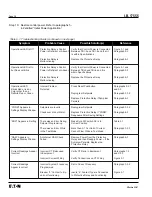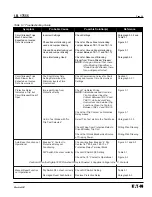
I.B. 17555
Page 24
Effective 03/97
moved independently in a horizontal direction. Figure 3-
9 graphically illustrates this horizontal movement.
The instantaneous protection (INST) is designed to pro-
vide a minimum 2 cycle total response time. To provide
this fast response time the rms current detection level
and display readout may differ somewhat from a true
rms ampere value, if a significant percentage harmonic
current is present.
Ground Fault Protection
The ground fault protection function can be a composite
of the ground: 1) inverse time overcurrent curve shape,
pickup, and time, 2) short delay pickup and time,
3) instantaneous pickup. Its curve shape is independent
of the phase curve. There are two differences between
Digitrip 3000 phase and ground functions: 1) Inverse
time overcurrent time multiplier values for the ground
function of the thermal curves are for (1 x I
n
) while the
phase is (3 x I
n
). 2) The short delay settings are more
sensitive and can be set from (0.1 x I
n
) to (11 x I
n
).
Movement of the pickup portion of the curve in a hori-
zontal direction and the time portion of the curve in a
vertical direction is similar to phase inverse time over-
current, short delay and instantaneous functions previ-
ously described. Therefore, ground fault curve move-
ment is not graphically illustrated. Refer to Table 2.3 for
the available ground fault settings. When programming
ground fault protection, keep in mind that if “NONE” is
selected, the ground fault protection is disabled. Even if
the ground fault protection is disabled, a detectable
ground current will still be displayed.
Characteristic Curve Reminders
As previously mentioned, combining protective capabili-
ties is a matter of coordination. The effects of one selec-
tion should always be evaluated against other selections
to determine if the overall desired result is obtained. For
this reason, keep in mind the following Digitrip 3000
selection possibilities and relay design features when
programming the unit to closely coordinate with system
protective needs:
1. When “NONE” is selected as a setting, the associat-
ed tripping function is disabled.
2. When “NONE” is selected for the Phase Instantaneous
Setting, a Phase Discriminator option is offered.
3. The internal design of the Digitrip 3000 Protective
Relay is such that the Short Delay Time setting might
take precedence over the Inverse Time Overcurrent
Time. This is graphically illustrated in Figure 3-8.
3-3.2 PROGRAM MODE
DIGITRIP 3000 PROTECTIVE RELAY SETTINGS
MUST BE PROGRAMMED BEFORE THE RELAY IS
PUT INTO OPERATION. CARE MUST BE TAKEN
WHEN PROGRAMMING THE DIGITRIP 3000 WHILE
THE BREAKER IS CLOSED AND CURRENT IS
FLOWING. AN INCORRECT SETTING CONFIGURA-
TION COULD CAUSE THE RELAY TO TRIP THE
BREAKER WHEN SETTINGS ARE SAVED.
Notes: 1. The Program Mode can be entered with the
circuit breaker open or closed, depending on
how DIP switch S2 is set. Refer to Table 5.1
for DIP switch settings. The circuit breaker
position is determined via the normally
closed breaker “b” contact on terminals 9 and
10 of TB1. Refer to the typical wiring diagram
in Figure 3-1.
2. The settings that are altered during a pro-
gramming session will not be saved until the
Save Settings pushbutton is pressed and
released.
3. If the circuit breaker is closed during a pro-
gramming session and DIP Switch S2 is set
to “off,” the unit will exit the Program Mode
without saving any new setpoint values and
the message “ERR” will appear in the
Settings/Test Time/Trip Cause window.
4. When programming is concluded and new
setpoints saved, the Program Mode pushbut-
ton should be pressed and released to exit
the Program Mode.
5. The Program Mode is also exited if the Reset
pushbutton is pressed and released or if
there is no programming activity for approxi-
mately 2-1/2 minutes.
Refer to Section 3-3.3 (Programming Overview) and the
following specific details to become familiar with the pro-
gramming process.
To enter the Program Mode, open the protective access
cover and press and release the Program Mode On/Off
pushbutton. The Program LED will blink green, indicat-
!
CAUTION
















































